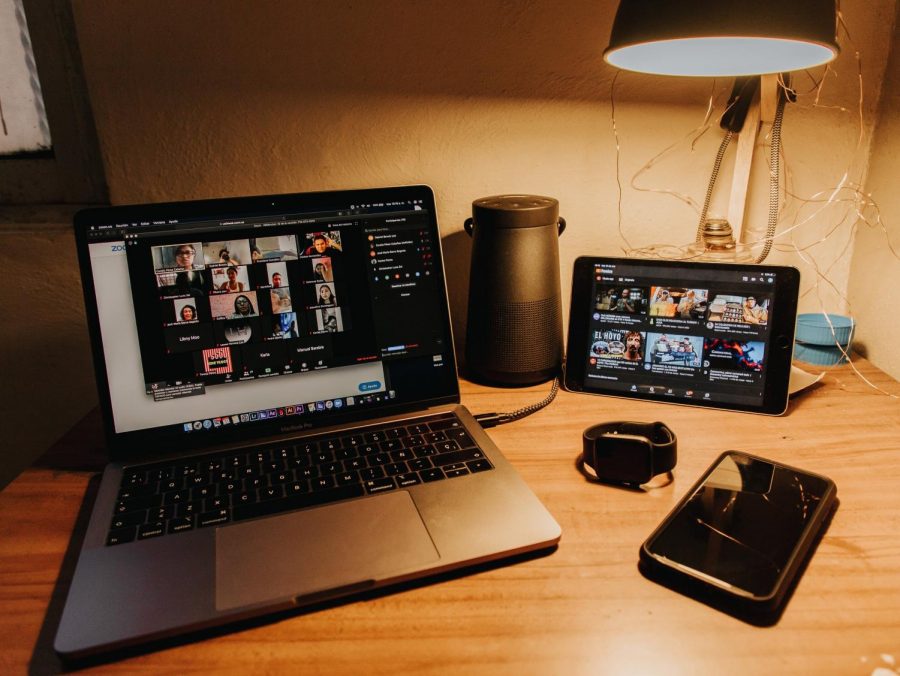Olathe’s return to online learning a negative for students
A typical student setup for remote learning, including a laptop on Zoom and a cell phone, as well as other electronic devices. The Olathe School District announced that all middle and high school students would return to online learning after Thanksgiving break, much to the dismay of many students.
November 20, 2020
The Olathe School District officially announced on Nov. 18 that in effort to mitigate the spread of COVID-19, all secondary students will return to remote learning, becoming the last of the “Big Three” of Johnson County, along with the Blue Valley and Shawnee Mission districts, to fall. The change will be until at least the end of semester, which differs from the other districts’ decision dates of Jan. 15 or later.
The switch back to online is one that seems the district didn’t want to make, as they were the final holdouts, but it was inevitable when the other two districts announced it, as the Olathe School District seems to simply follow what the other two do, almost as if the superintendents have a group chat to make decisions together.
A failure of the district is not telling the students directly, instead opting to email parents and teachers about the decision, as well as announcing it via their social media platforms. Why would the school district not tell the students, the body of people that is most directly impacted, about the change? Relying on the spreading of second-hand news is a rather cowardly decision and gives the appearance that they want to avoid the issue entirely, along with the backlash that would come with it from the students that are in-person and the parents that are strong advocates for in-person learning. Additionally, teachers had little notice to prepare for the upcoming transition, as they were notified the same day it was announced on social media.
The transition back to online will come with some changes from the first time around, as an email sent by Principal Dale Longnecker instructed that teachers should be teaching for no more than 40 minutes, assign asynchronous learning activities, and host discussion boards to assist in digital learning. It remains to be seen if teachers obey this stipulation, as many teachers held up students bell-to-bell, staying on Zoom for all 90 minutes of the class period despite explicit instructions not to do so. This was met with universal disdain across the student body, as they were told that they would be given time to do schoolwork during school, a promise that was not fulfilled at all.
The daily schedule will be the same as was used in September, with full block day schedules lasting until 3:00, which will feel like days stretching on endlessly, since the half-day hybrid model has been used for the past month to great acclaim from the student body. A total of 27 in-person school days is not nearly enough to have a productive school year, but going back to online is not the answer to make up for these shortcomings; instead, staying with hybrid would be a much better solution for all parties involved, as students that become uncomfortable with staying in school are being given the option to go back full-time to online at any point, even after being told that mid-semester switches would not be done.
Studies done since the COVID-19 pandemic began have shown that mental health and well-being on all accounts have significantly deteriorated, and it is fueled by being locked at home and staring at a computer screen all day. Since August, according to a study done by Ipsos, more than one in every three students are reporting worsening emotional health as a direct result of distance learning. In another survey by Core Spaces, 75% of the 2500 students surveyed reported that they felt more anxious or stressed due to online learning, with 90% wishing to return to in-person classes. The district attempted to combat this by having an advisory lesson encouraging students to seek help from the counselors while at home, but this fell flat on every account, with students being quick to criticize the school counselors as ineffective with their techniques for dealing with issues.
This also marks the temporary end to the Grab-and-Go lunch program, which allowed students to get a lunch for free. Many students took advantage of the opportunity, with lines stacking up to both pickup locations within minutes to get their sacked lunch, which included fruit, a student’s choice of drink, and an assortment of microwavable foods. This means that the students that took a sack will instead either be forced to spend their own money to purchase food, or will eat food at home, costing their parents an extra bit of money.
Classes with long-term assignments that require in-person interaction are also put into lame duck positions, and publications that typically deliver hard copies of their issues are also restricted to online. This is a recipe for disaster for underclassmen, as they will not get the experience of using regular programs like InDesign that don’t work well on the underpowered school-issued laptops. With seniors potentially graduating after a fully-online second semester, staff veterans would graduate and would take away the software knowledge that they could have passed on to younger and inexperienced members. Members of the performing arts are also being forced to have online performances or forgo them entirely, stripping seniors of their final acts in high school.
All in all, the hybrid model is definitely the way to continue if the school district wants to have a productive school year and prepare students for their next grade level, whether that be freshmen (who have only been in their buildings for a single month) going into their sophomore year or seniors graduating into college. A break year, for lack of a better term, is in the complete opposite of the best interest of the students.

